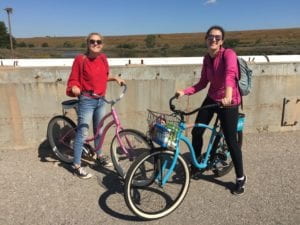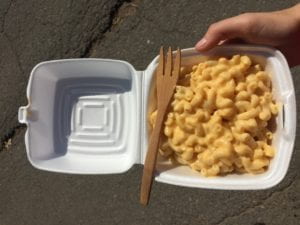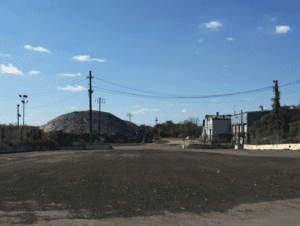 A landfill turned urban parkland seems an unlikely way to deal with waste but that is exactly what’s happening at Freshkills Park in Staten Island. Fresh Kills Landfill, once the largest in the world was officially capped and closed in 2001. Since then the site has transformed into a 2,200 acre urban park. The soil infrastructure layered over the landfill has allowed the site to become a distinct space for wildlife, recreation, and education. The park is still in the works and will not be officially open to the public until 2036. However, the Freshkills Park Alliance provides regular opportunities for people to visit and engage with the site through hiking, biking, photography, and more.
A landfill turned urban parkland seems an unlikely way to deal with waste but that is exactly what’s happening at Freshkills Park in Staten Island. Fresh Kills Landfill, once the largest in the world was officially capped and closed in 2001. Since then the site has transformed into a 2,200 acre urban park. The soil infrastructure layered over the landfill has allowed the site to become a distinct space for wildlife, recreation, and education. The park is still in the works and will not be officially open to the public until 2036. However, the Freshkills Park Alliance provides regular opportunities for people to visit and engage with the site through hiking, biking, photography, and more.
 Some members of EarthMatters, including myself were lucky enough to visit Freshkills on park’s most recent Discovery Day. We all started off by renting free bikes and cruising through the park on one of the marked trails. While some people split off to partake in a walking tour with NYC Audubon or a Hawk Hike with Urban Park Rangers, others continued to peddle on a combination of paved and gravel trails while waiting for another guided tour featuring the Landfill History and Transition.
Some members of EarthMatters, including myself were lucky enough to visit Freshkills on park’s most recent Discovery Day. We all started off by renting free bikes and cruising through the park on one of the marked trails. While some people split off to partake in a walking tour with NYC Audubon or a Hawk Hike with Urban Park Rangers, others continued to peddle on a combination of paved and gravel trails while waiting for another guided tour featuring the Landfill History and Transition.
There were a number of things going on throughout the day, such as kid-friendly activities including informational ranger stations as well as an NYC Parks Play Mobile van equipped with an impromptu soccer zone, face painting and more.
One thing that is unavoidable when standing on top of layers and layers of landfill is the treatment of waste. Aside from the actual capped mounds of landfill that can be spotted around the park, it was also interesting to see the way that the Freshkills team is directly working with trash.
There were clearly marked separate bins for trash and recycling, though ironically there didn’t seem to be much of an effort to reduce waste. The advertized “water stations” consisted of unmarked piles of plastic water bottles. Implementing fresh drinking water and fountains into a landfill based system definitely poses a challenge. However, it would have been nice to be able to fill up our own reusable bottles at a refill station with something as simple as coolers filled with tap water.
A single food truck sold picnic and BBQ style food. There was no indication of whether or not the food was local or sustainable and what’s worse, I had to use my NYUGREeN bamboo fork to eat mac n cheese out of a styrofoam container! Gasp! It did seem a little contradictory to the mission of the park which is directed at a solution to landfill. Shouldn’t we begin with reducing trash in the first place?
Overall everyone seemed to be enjoying the sunshine and relaxed atmosphere of the park regardless of the very faint scent of trash in the air. The bikes were definitely a highlight for the group and a personal favorite.
 It is clear that the Freshkills Park Alliance is working hard to engage the public with the site. However, because it is such a large space it does seem slightly overwhelming and certainly comes across as a work in progress. Nonetheless, it is an extremely exciting project that both confronts the public with the massive issue of waste and provides a positive solution.
It is clear that the Freshkills Park Alliance is working hard to engage the public with the site. However, because it is such a large space it does seem slightly overwhelming and certainly comes across as a work in progress. Nonetheless, it is an extremely exciting project that both confronts the public with the massive issue of waste and provides a positive solution.
Make sure to visit the Freshkills website to learn more about the project, history of the site and for future events!

Wow, the kills are so fresh!
I think this looks like an interesting project, and certainly, should (one would hope) bring the issues of landfill to the attention of anyone who visits the park, albeit not for another 19 years or so 🙁
It sounds like a massive job to transform this into a space that people will be able to enjoy again, safely and free from the toxic nature of landfill.
But how many other 30 year + projects are we going to have to start to overcome the landfill issue? Why on earth can we just not recycle more, not consume so much, work to create a more closed system at home. Composting, growing our own food, bartering, sharing, and just reduce our need to consume more and more.
I dread to think what the world will be like in 50 years is we continue at the current pace 🙁
Thanks for the write up, super interesting.